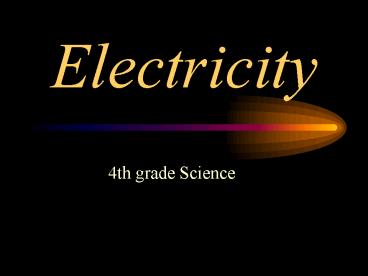Electricity - PowerPoint PPT Presentation
1 / 23
Title:
Electricity
Description:
Electricity 4th grade Science What is an electric current? A flow of electrical charges Important Fact Electric current will only flow through a complete circuit. – PowerPoint PPT presentation
Number of Views:737
Avg rating:3.0/5.0
Title: Electricity
1
Electricity
4th grade Science
2
What is an electric current?
- A flow of electrical charges
3
Important FactElectric current will only flow
through a complete circuit.
4
Making a Circuit
- You need a path to carry the electricity. This
path along which an electric current flows is a
circuit. - 3 basic parts of a circuit
- power source (ex. battery)
- load (a lamp or a bulb, etc.)
- connectors (ex. wires) They carry the electric
charges between the power source and the load.
5
Making a Circuit
- Many circuits have a switch.
- It turns the electric current on and off.
- Ex. the lights in a room turn on with a switch
- Closed Vs. Open Circuits
- The circuit cannot have any breaks or the
electric current can not flow. - A closed circuit is complete and unbroken.
- An open circuit has breaks or openings.
6
Did you Know?
- When a bulb burns out, a wire inside of it
breaks in two. This causes the circuit to no
longer have a complete path. It is now an open
circuit and electric current cannot flow through
it.
7
Lets try it!
- Materials power source (battery), connectors
(three wires), load (bulb), and switch - Investigation Create a closed circuit that will
allow the electric current to flow.
8
Can you turn this complete, closed circuit into
an open circuit?
- Open the switch!
9
What is a series circuit?
- All electrical charges flow in the same direction
- The parts are connected in one loop
- Electric current moves along one path
- current goes from power source to load then to
another load and finally returns to power source
through wires - All of the parts are connected one after another
10
Lets try it!Build a series circuit...
- Materials power source (battery), battery
holder, connectors (three wires), 2 loads (bulb),
and bulb holders - Investigation Create a series circuit.
11
Series Circuits
12
Lets try it!Build a series circuit...
- Unscrew one of the light bulbs.
- Does the light bulb still light up? Why or why
not?
13
Questions to Ponder...
- One bulb burns out in a series circuit. Will
current flow in the circuit? - A string of small lights are an example of a
series circuit. If the first light goes out,
what happens to the others? What if the last
light burns out?
14
What is a parallel circuit?
- All electrical charges flow through more than one
path. These different paths are referred to as
branches. - Some of the electric current flows through one
branch and some flows through another branch
15
Lets try it!Build a parallel circuit...
- Materials power source (battery), battery
holder, connectors (4 wires), 2 loads (bulb), and
2 bulb holders - Investigation Create a parallel circuit.
16
Parallel Circuits
17
Lets try it!Build a parallel circuit...
- Unscrew one of the light bulbs.
- Does the light bulb still light up? Why or why
not?
18
With a parallel circuit...
- If any branch of the parallel circuit breaks or
is removed, current will still flow through the
other branches. - If the light bulb on one branch burns out, the
light bulbs on other branches will still glow.
19
Did you know?
- You can have a combination of a series and
parallel circuit. Many circuits in electrical
devices, even circuits in your home, are
combination circuits!
20
What affects electric current?
- Voltage
- strength of a power source
- a power source with more voltage can produce more
electric current - measure in units called volts
21
What affects electric current?
- Resistance
- ability of a substance to oppose or slow down
electric current - increasing the resistance of a circuit decreases
the flow of electric charges - also allows electrical energy to be changed into
other forms of energy Ex. light or heat - Very little resistancecopper wires-can carry a
great deal of electric current CONDUCTOR - Large amount of resistancerubber-it is difficult
to make electric current flow through it
INSULATOR
22
Questions to Ponder...
- If you add bulbs to a series circuit, the circuit
has higher resistance. What happens to the
electric current in the circuit? - If you decrease the resistance of a circuit, what
will happen to current in the circuit?
23
What is a short circuit?
- A path with almost no resistance
- It can stop the rest of the circuit from
operating properly. - Can be dangerous!
- The wire heats up and may cause a fire.

